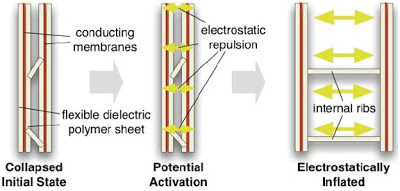1. Electrostatic Active Space Radiation Shielding for Deep Space Missions
This study will seek to test and validate an electrostatic gossamer structure to provide radiation shielding. It will provide guidelines for energy requirements, dose reduction and deflection efficiencies, and effective enhancements of dual electrostatic-passive (material) shielding technologies, and ‘engineering-feasible’ architectures.
Ram Tripathi, has been funded through NASA’s Innovative Advanced Concepts (NIAC) Program to develop an electrostatic shielding system that bends radiation particles away from spacecraft.
The system concept utilizes structures that employ either a positive and negative charge. Because like charges repel, the negatively charged structures will repel negative radiation (plasma) and positively charged structures will repel positive radiation (ions). By organizing the structures in certain configurations, they can ward off radiation by creating a safe zone for a spacecraft and its crew.“At a minimum, it’s 75% more effective than the ideal material shielding, which is an enormous advantage” said Tripathi.
Through validation testing, Tripathi has proven that the concept works. He is currently looking at which configurations will work best and focusing on developing the technological aspects of the system. He has also identified gossamer as the build material for structures because it possesses many qualities that would benefit the system, most importantly, it’s lightweight.
“Payload is a dictating factor. If payload is not right, if you don’t get off the ground, then you aren’t in business. And gossamer has been successful within NASA, so why not take advantage of that? We are here to take advantage of whatever exists, rather than re-inventing the wheel all of the time.”
By coupling an active radiation shielding technology, like an electrostatic system, with other passive shielding technologies, Tripathi believes a radiation safe environment can be created for astronauts travelling into deep space. However, there is still a lot of work that needs to be done first.
“This is the golden time for radiation, everything you do here is new because nothing has been done, it’s truly and exciting time.”
2. Radiation Protection and Architecture Utilizing High Temperature Superconducting Magnets
The concept of shielding astronauts with magnetic/electric fields has been studied for over 40 years and has remained an intractable engineering problem. Superconducting magnet technology has made great strides in the last decade. Coupling maturing technology with potential innovative magnet configurations, this proposal aims to revisit the concept of active magnetic shielding. The focus of the proposed work is to analyze new coil configurations with current technology and compare shielding performance and design mass with alternate passive shielding methods.
The objectives and expected significance of the proposed research are to develop a space radiation shielding material system that has high efficacy for shielding radiation and that also has high strength for load bearing primary structures. Such a material system does not yet exist. The NASA Langley Research Center (LaRC), Jefferson National Lab (JNL), and National Institute of Aerospace (NIA) as joint owners have recently synthesized long, highly crystalline boron nitride nanotubes (BNNT) using a novel pressure/vapor condensation method. The BNNT have extraordinary strength and high temperature stability. The BNNT are made up entirely of low Z (atomic number) atoms – boron and nitrogen. The BNNT can theoretically be processed into structural BNNT and used for load bearing structure. The BNNT are nanotubes; their molecular structure is attractive for hydrogenation. A comprehensive literature search – as well as independent thinking – will be performed to determine what is the best processing approach for hydrogenating the BNNT.
Neutrons are produced as secondary radiation when the galactic cosmic radiation (GCR) and solar energetic particles (SEP) interact with the walls of the space structure (vehicle, lander, habitat) and also with the regolith on the surfaces of Moon or planets. This secondary neutron radiation has largely been ignored in previous space architectures and yet neutron radiation is known to be damaging to humans especially with regard to the formation of radiogenic cancers. Radiation protection is an enabling technology for future exploration missions. The Agency cannot support human missions greater than approximately 90 to 100 days beyond low Earth orbit (LEO) without developing shielding and/or biological countermeasures to remain below Permissible Exposure Limits. The Success Criteria are adequate shielding measures to enable safety of crew and hardware during long duration human missions up to 1 year in space. It is the intent of the proposed research to bring the Agency closer to extending space missions beyond the 100 days, with 1 year as a long-term goal.
If you liked this article, please give it a quick review on ycombinator or StumbleUpon. Thanks

Brian Wang is a Futurist Thought Leader and a popular Science blogger with 1 million readers per month. His blog Nextbigfuture.com is ranked #1 Science News Blog. It covers many disruptive technology and trends including Space, Robotics, Artificial Intelligence, Medicine, Anti-aging Biotechnology, and Nanotechnology.
Known for identifying cutting edge technologies, he is currently a Co-Founder of a startup and fundraiser for high potential early-stage companies. He is the Head of Research for Allocations for deep technology investments and an Angel Investor at Space Angels.
A frequent speaker at corporations, he has been a TEDx speaker, a Singularity University speaker and guest at numerous interviews for radio and podcasts. He is open to public speaking and advising engagements.






